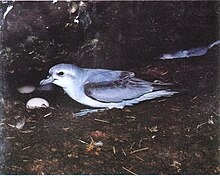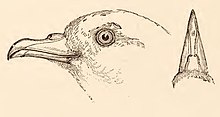| Fairy prion | |
|---|---|

| |
| Conservation status | |
 Least Concern (IUCN 3.1) | |
| Scientific classification | |
| Domain: | Eukaryota |
| Kingdom: | Animalia |
| Phylum: | Chordata |
| Class: | Aves |
| Order: | Procellariiformes |
| Family: | Procellariidae |
| Genus: | Pachyptila |
| Species: | P. turtur |
| Binomial name | |
| Pachyptila turtur (Kuhl, 1820) | |

| |
The fairy prion (Pachyptila turtur) is a small seabird with the standard prion plumage of blue-grey upperparts with a prominent dark "M" marking and white underneath. The sexes are alike. It is a small prion which frequents the low subantarctic and subtropic seas.
Taxonomy
The fairy prion was formally described in 1820 by the German naturalist Heinrich Kuhl under the binomial name Procellaria turtur. It is now placed with the other prions in the genus Pachyptila, introduced in 1811 by Johann Karl Wilhelm Illiger. The genus name combines the Ancient Greek pakhus , meaning "dense" or "thick", with ptilon, meaning "feather" or "plumage". The specific epithet turtur is Latin for "turtle dove". The word prion comes from the Ancient Greek word priōn, meaning "a saw", which refers to the serrated edges of its bill.
The fairy prion is a member of the genus Pachyptila and of the subgenus Pseudoprion Coues, 1866. Along with the blue petrel, they make up the prions. They in turn are members of the family Procellariidae, and the order Procellariiformes. Prions are small and typically eat just zooplankton but, as members of the Procellariiformes, they share certain identifying features. They have nasal passages, called naricorns, that attach to the upper bill, as opposed to the nostrils on the albatross which are on the sides of the bill. The bills of Procellariiformes are also unique in that they are split into between seven and nine horny plates.
The birds produce a stomach oil made up of wax esters and triglycerides that is stored in the proventriculus, and is used against predators, as well as providing an energy rich food source for chicks, and for the adults during their long flights. They also have a salt gland above the nasal passage which excretes a high saline solution from their nose, helping to desalinate their bodies, due to the large quantity of ocean water that they imbibe. It.
Description


The fairy prion is around 25 cm (9.8 in) in length, with a wingspan of 56 cm (22 in). The plumage is blue-grey on its upperparts with a dark "M" extending to the wingtips. The tail is wedge-shaped with a dark tip. The underparts are mostly white. It has a pale blue bill with blue legs and feet. The sexes are alike. In appearance, it is very similar to the fulmar prion (Pachyptila crassirostris), and the two species cannot be distinguished at sea.
Distribution and habitat
The fairy prion is found throughout oceans and coastal areas in the Southern Hemisphere. Their colonies can be found in the Falklands Isles, the Bass Strait Islands of Australia, the Crozet Isles, as well as the Chatham Islands, the Antipodes Islands, and the Snares Islands of New Zealand amongst many other places.
Behavior
Food and feeding
The diet consists mainly of planktonic crustaceans and tiny fish, which they catch by either seizing prey while on the surface or by dipping their bill into the water while in flight.
Breeding
They breed colonially and prefer small islands. Nests are situated in soil, hidden by vegetation, and dug with the bill or feet, or in a hollow in a crevice. When coming back to their nest at night, they will coo softly and listen for their mate.
Conservation
Widespread and common throughout its large range, with an estimated population of 5,000,000, the fairy prion is evaluated as least concern on the IUCN Red List of Threatened Species. Its range is 24,600,000 km (9,500,000 sq mi).
References
- ^ BirdLife International (2018). "Pachyptila turtur". IUCN Red List of Threatened Species. 2018: e.T22698124A132626982. doi:10.2305/IUCN.UK.2018-2.RLTS.T22698124A132626982.en. Retrieved 12 November 2021.
- Kuhl, Heinrich (1820). Beiträge zur Zoologie und vergleichenden Anatomie (in German and Latin). Frankfurt am Main: Verlag der Hermannschen Buchhandlung. p. 143.
- Illiger, Johann Karl Wilhelm (1811). Prodromus systematis mammalium et avium (in Latin). Berolini : Sumptibus C. Salfeld. p. 274.
- Jobling, James A. (2010). The Helm Dictionary of Scientific Bird Names. London: Christopher Helm. p. 288, 393. ISBN 978-1-4081-2501-4.
- Gotch, A. F. (1995) . "Albatrosses, Fulmars, Shearwaters, and Petrels". Latin Names Explained A Guide to the Scientific Classifications of Reptiles, Birds & Mammals. New York, NY: Facts on File. p. 192. ISBN 0-8160-3377-3.
- Maynard, B. J. (2003). "Shearwaters, petrels, and fulmars (Procellariidae)". In Hutchins, Michael; Jackson, Jerome A.; Bock, Walter J.; Olendorf, Donna (eds.). Grzimek's Animal Life Encyclopedia. Vol. 8 Birds I Tinamous and Ratites to Hoatzins. Joseph E. Trumpey, Chief Scientific Illustrator (2nd ed.). Farmington Hills, MI: Gale Group. pp. 123–133. ISBN 0-7876-5784-0.
- Double, M. C. (2003). "Procellariiformes (Tubenosed Seabirds)". In Hutchins, Michael; Jackson, Jerome A.; Bock, Walter J.; Olendorf, Donna (eds.). Grzimek's Animal Life Encyclopedia. Vol. 8 Birds I Tinamous and Ratites to Hoatzins. Joseph E. Trumpey, Chief Scientific Illustrator (2nd ed.). Farmington Hills, MI: Gale Group. pp. 107–111. ISBN 0-7876-5784-0.
- Ehrlich, Paul R.; Dobkin, David, S.; Wheye, Darryl (1988). The Birders Handbook (First ed.). New York, NY: Simon & Schuster. pp. 29–31. ISBN 0-671-65989-8.
{{cite book}}: CS1 maint: multiple names: authors list (link) - ^ Marchant, S.; Higgins, P.G., eds. (1990). "Pachyptila turtur Fairy Prion" (PDF). Handbook of Australian, New Zealand & Antarctic Birds. Volume 1: Ratites to ducks; Part A, Ratites to petrels. Melbourne, Victoria: Oxford University Press. pp. 541–549. ISBN 978-0-19-553068-1.
- ^ Harrison, C.; Greensmith, A. (1993). Bunting, E. (ed.). Birds of the World. New York, NY: Dorling Kindersley. p. 51. ISBN 1-56458-295-7.
- "Fairy Prion (Pachyptila turtur) - BirdLife species factsheet". datazone.birdlife.org. Retrieved 2024-01-31.
- Harper (1987). "Feeding behaviour and other notes on 20 species of Procellariiformes at sea". Notornis. 34 (3): 169–192. Archived from the original on 2022-01-30. Retrieved 2022-01-19.
- BirdLife International (2009)
Sources
- Double, M. C. (2003). "Procellariiformes (Tubenosed Seabirds)". In Hutchins, Michael; Jackson, Jerome A.; Bock, Walter J.; Olendorf, Donna (eds.). Grzimek's Animal Life Encyclopedia. Vol. 8 Birds I Tinamous and Ratites to Hoatzins. Joseph E. Trumpey, Chief Scientific Illustrator (2nd ed.). Farmington Hills, MI: Gale Group. pp. 107–111. ISBN 0-7876-5784-0.
- Ehrlich, Paul R.; Dobkin, David, S.; Wheye, Darryl (1988). The Birders Handbook (First ed.). New York, NY: Simon & Schuster. pp. 29–31. ISBN 0-671-65989-8.
{{cite book}}: CS1 maint: multiple names: authors list (link) - Gotch, A. F. (1995) . "Albatrosses, Fulmars, Shearwaters, and Petrels". Latin Names Explained A Guide to the Scientific Classifications of Reptiles, Birds & Mammals. New York, NY: Facts on File. p. 192. ISBN 0-8160-3377-3.
- Harrison, C.; Greensmith, A. (1993). Bunting, E. (ed.). Birds of the World. New York, NY: Dorling Kindersley. p. 51. ISBN 1-56458-295-7.
- Maynard, B. J. (2003). "Shearwaters, petrels, and fulmars (Procellariidae)". In Hutchins, Michael; Jackson, Jerome A.; Bock, Walter J.; Olendorf, Donna (eds.). Grzimek's Animal Life Encyclopedia. Vol. 8 Birds I Tinamous and Ratites to Hoatzins. Joseph E. Trumpey, Chief Scientific Illustrator (2nd ed.). Farmington Hills, MI: Gale Group. pp. 123–133. ISBN 0-7876-5784-0.
External links
| Taxon identifiers | |
|---|---|
| Pachyptila turtur |
|
| Procellaria turtur | |
- IUCN Red List least concern species
- Pachyptila
- Birds of the Falkland Islands
- Birds of the Chatham Islands
- Birds of the Indian Ocean
- Birds of New South Wales
- Birds of New Zealand
- Birds of islands of the Atlantic Ocean
- Birds of Tasmania
- Birds of Victoria (state)
- Birds of the Campbell Islands
- Fauna of the Crozet Islands
- Fauna of the Prince Edward Islands
- Birds described in 1820